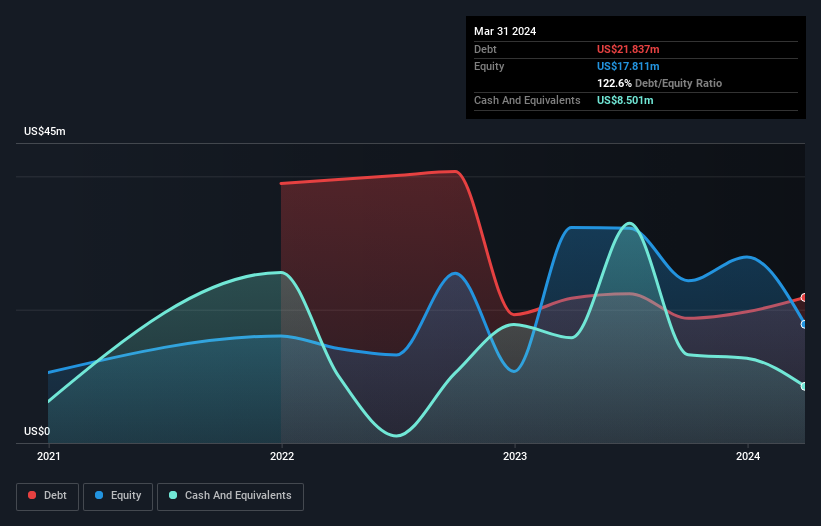- United States
- /
- Electrical
- /
- NasdaqCM:DFLI
Health Check: How Prudently Does Dragonfly Energy Holdings (NASDAQ:DFLI) Use Debt?

Howard Marks put it nicely when he said that, rather than worrying about share price volatility, 'The possibility of permanent loss is the risk I worry about... and every practical investor I know worries about.' So it might be obvious that you need to consider debt, when you think about how risky any given stock is, because too much debt can sink a company. We can see that Dragonfly Energy Holdings Corp. (NASDAQ:DFLI) does use debt in its business. But the more important question is: how much risk is that debt creating?
When Is Debt A Problem?
Debt and other liabilities become risky for a business when it cannot easily fulfill those obligations, either with free cash flow or by raising capital at an attractive price. If things get really bad, the lenders can take control of the business. While that is not too common, we often do see indebted companies permanently diluting shareholders because lenders force them to raise capital at a distressed price. Having said that, the most common situation is where a company manages its debt reasonably well - and to its own advantage. The first thing to do when considering how much debt a business uses is to look at its cash and debt together.
See our latest analysis for Dragonfly Energy Holdings
How Much Debt Does Dragonfly Energy Holdings Carry?
The chart below, which you can click on for greater detail, shows that Dragonfly Energy Holdings had US$21.8m in debt in March 2024; about the same as the year before. On the flip side, it has US$8.50m in cash leading to net debt of about US$13.3m.

A Look At Dragonfly Energy Holdings' Liabilities
We can see from the most recent balance sheet that Dragonfly Energy Holdings had liabilities of US$43.5m falling due within a year, and liabilities of US$27.1m due beyond that. Offsetting these obligations, it had cash of US$8.50m as well as receivables valued at US$2.25m due within 12 months. So its liabilities total US$59.9m more than the combination of its cash and short-term receivables.
Given this deficit is actually higher than the company's market capitalization of US$51.7m, we think shareholders really should watch Dragonfly Energy Holdings's debt levels, like a parent watching their child ride a bike for the first time. In the scenario where the company had to clean up its balance sheet quickly, it seems likely shareholders would suffer extensive dilution. When analysing debt levels, the balance sheet is the obvious place to start. But it is future earnings, more than anything, that will determine Dragonfly Energy Holdings's ability to maintain a healthy balance sheet going forward. So if you're focused on the future you can check out this free report showing analyst profit forecasts.
In the last year Dragonfly Energy Holdings had a loss before interest and tax, and actually shrunk its revenue by 33%, to US$58m. To be frank that doesn't bode well.
Caveat Emptor
While Dragonfly Energy Holdings's falling revenue is about as heartwarming as a wet blanket, arguably its earnings before interest and tax (EBIT) loss is even less appealing. Indeed, it lost a very considerable US$23m at the EBIT level. When we look at that alongside the significant liabilities, we're not particularly confident about the company. We'd want to see some strong near-term improvements before getting too interested in the stock. Not least because it burned through US$24m in negative free cash flow over the last year. So suffice it to say we consider the stock to be risky. There's no doubt that we learn most about debt from the balance sheet. However, not all investment risk resides within the balance sheet - far from it. These risks can be hard to spot. Every company has them, and we've spotted 5 warning signs for Dragonfly Energy Holdings (of which 2 are a bit unpleasant!) you should know about.
If you're interested in investing in businesses that can grow profits without the burden of debt, then check out this free list of growing businesses that have net cash on the balance sheet.
If you're looking to trade Dragonfly Energy Holdings, open an account with the lowest-cost platform trusted by professionals, Interactive Brokers.
With clients in over 200 countries and territories, and access to 160 markets, IBKR lets you trade stocks, options, futures, forex, bonds and funds from a single integrated account.
Enjoy no hidden fees, no account minimums, and FX conversion rates as low as 0.03%, far better than what most brokers offer.
Sponsored ContentNew: Manage All Your Stock Portfolios in One Place
We've created the ultimate portfolio companion for stock investors, and it's free.
• Connect an unlimited number of Portfolios and see your total in one currency
• Be alerted to new Warning Signs or Risks via email or mobile
• Track the Fair Value of your stocks
Have feedback on this article? Concerned about the content? Get in touch with us directly. Alternatively, email editorial-team (at) simplywallst.com.
This article by Simply Wall St is general in nature. We provide commentary based on historical data and analyst forecasts only using an unbiased methodology and our articles are not intended to be financial advice. It does not constitute a recommendation to buy or sell any stock, and does not take account of your objectives, or your financial situation. We aim to bring you long-term focused analysis driven by fundamental data. Note that our analysis may not factor in the latest price-sensitive company announcements or qualitative material. Simply Wall St has no position in any stocks mentioned.
Have feedback on this article? Concerned about the content? Get in touch with us directly. Alternatively, email editorial-team@simplywallst.com
About NasdaqCM:DFLI
Dragonfly Energy Holdings
Engages in the manufacturing and sale of deep cycle lithium-ion batteries for recreational vehicles, marine vessels, solar and off-grid residence industries, and industrial and energy storage markets.
High growth potential and fair value.


